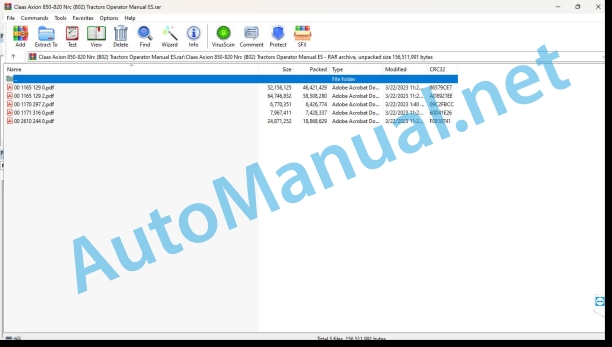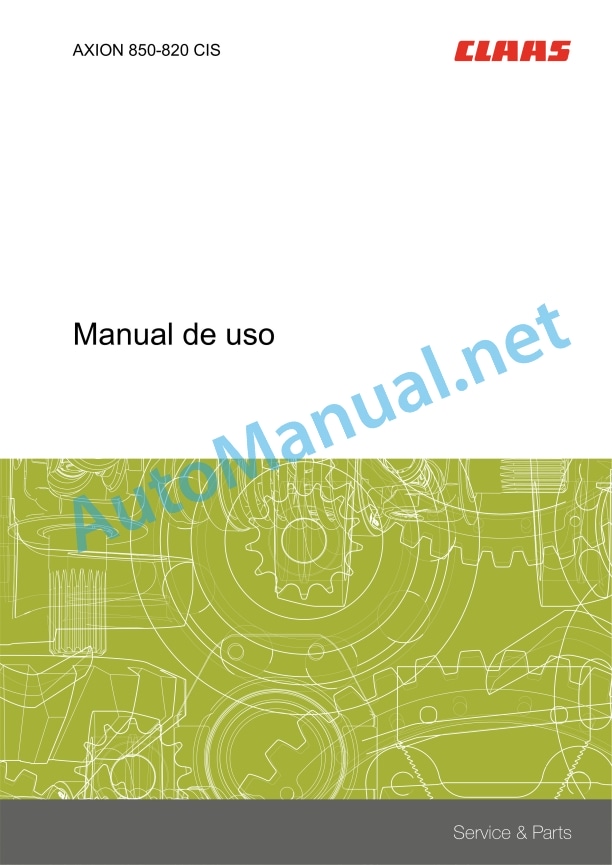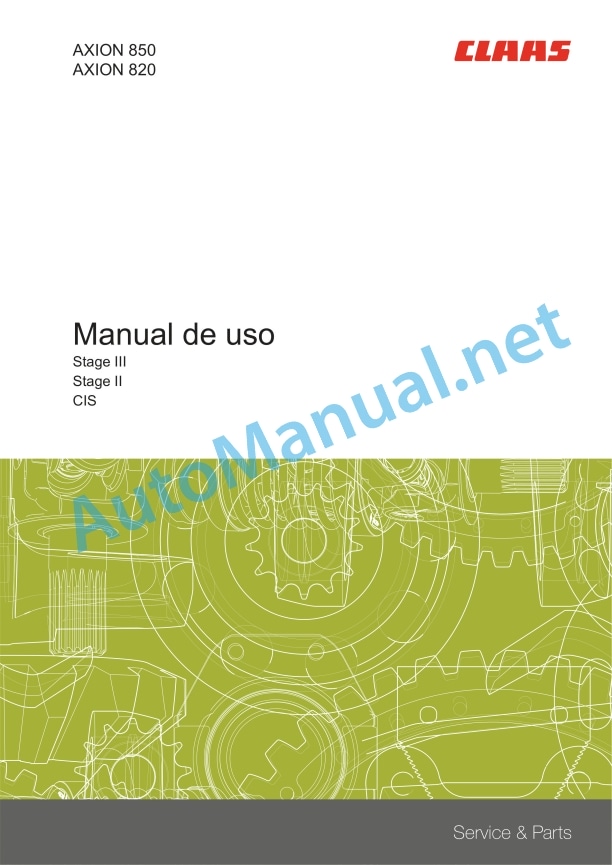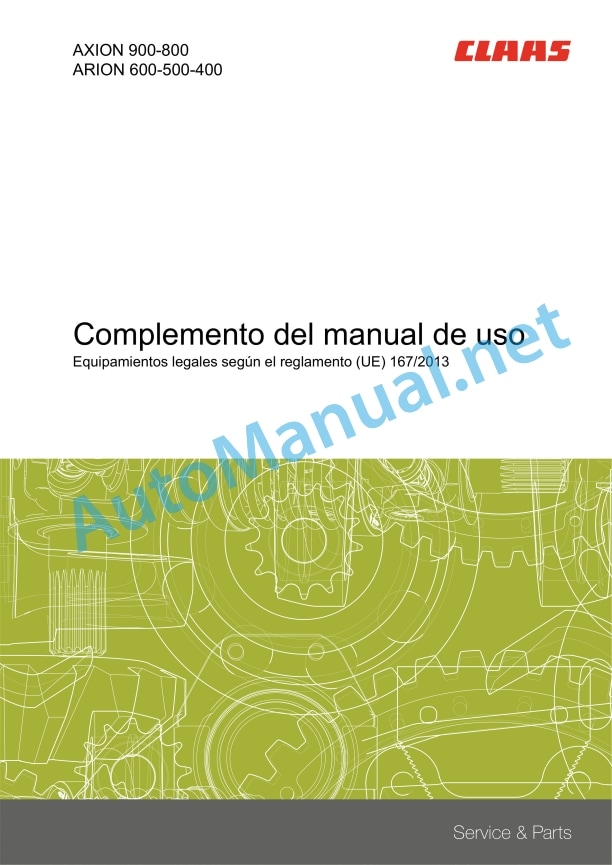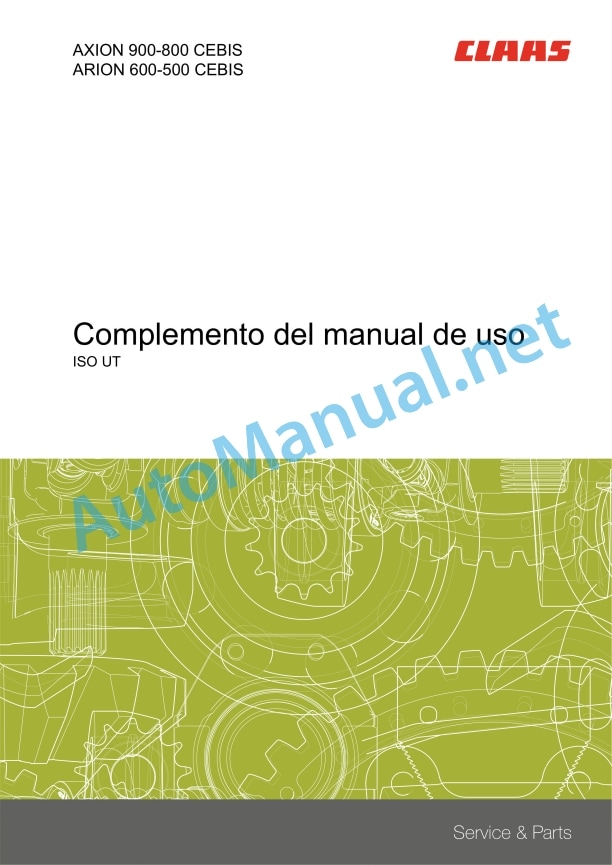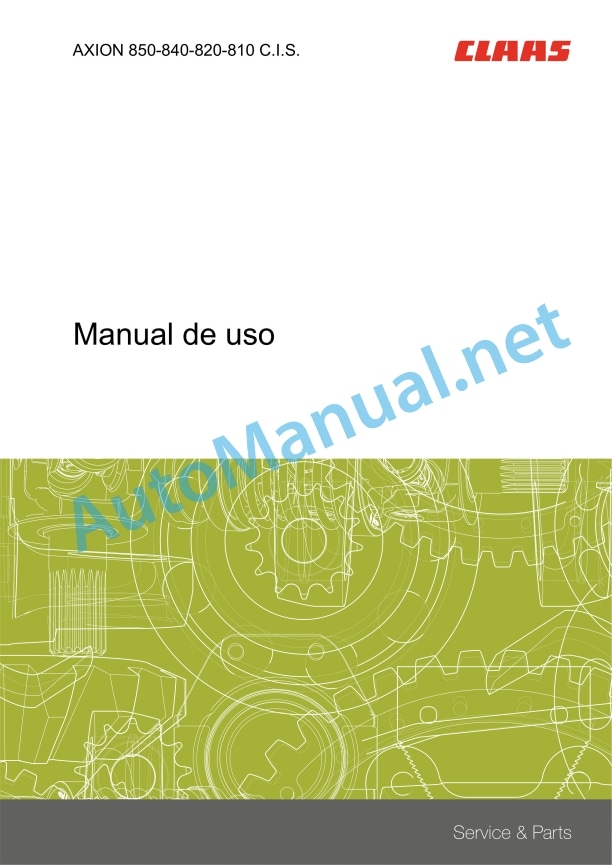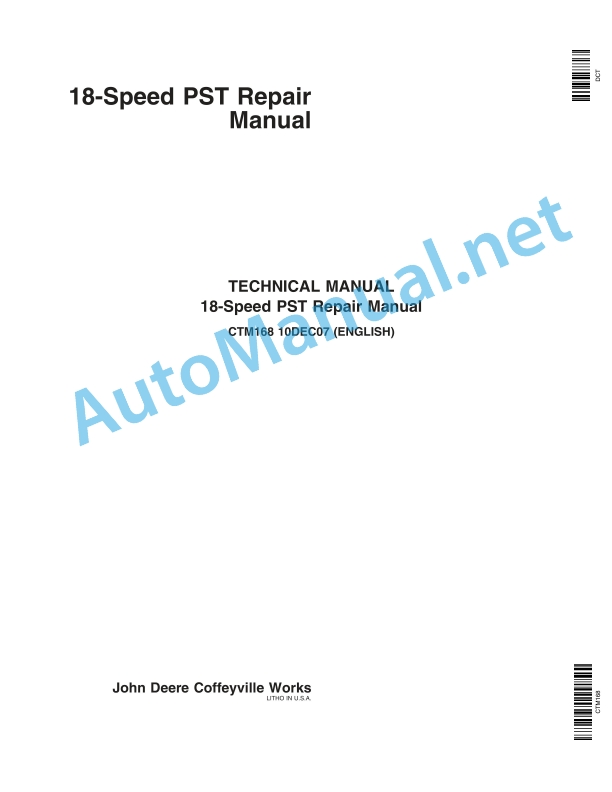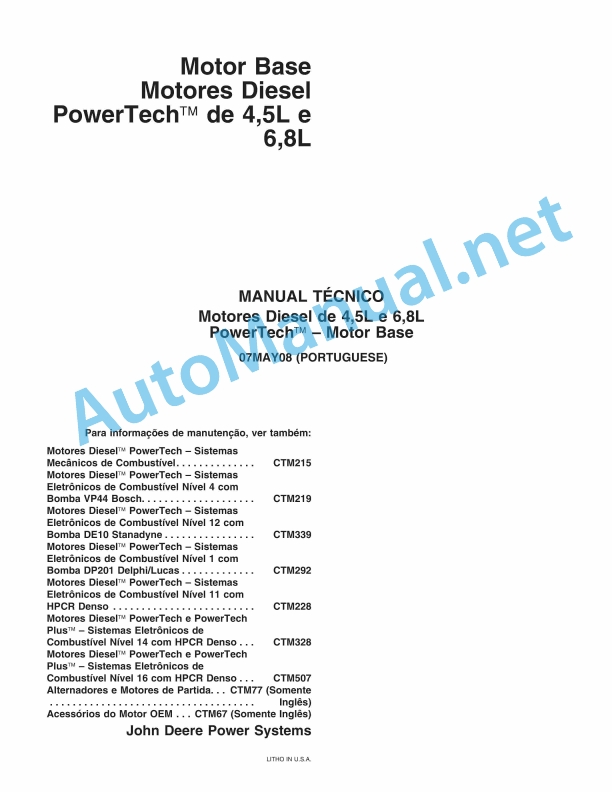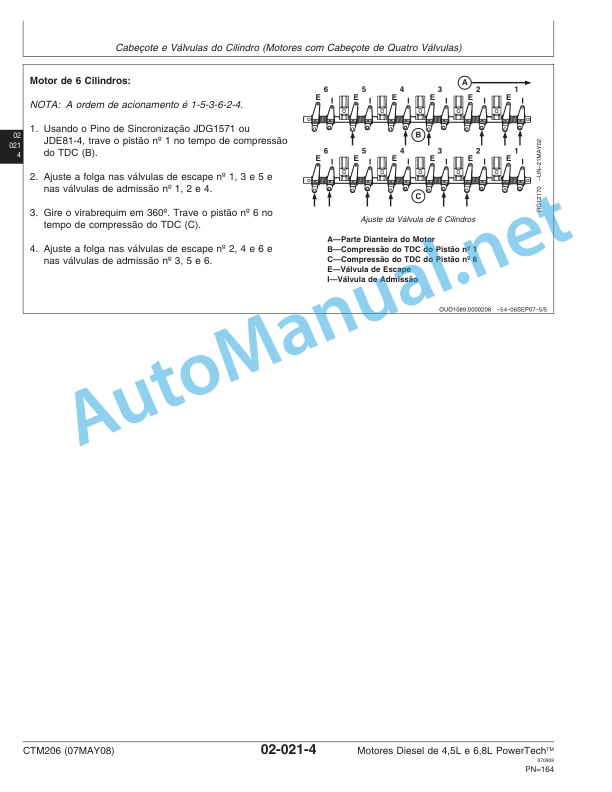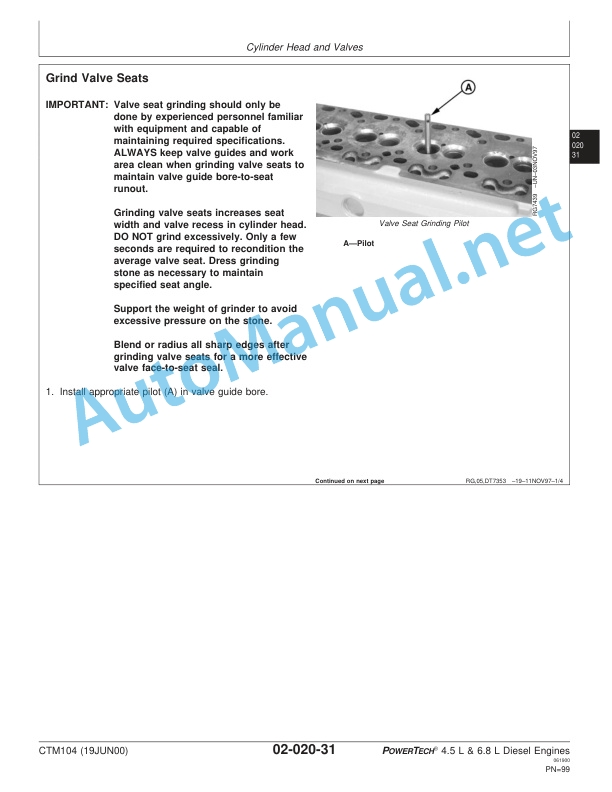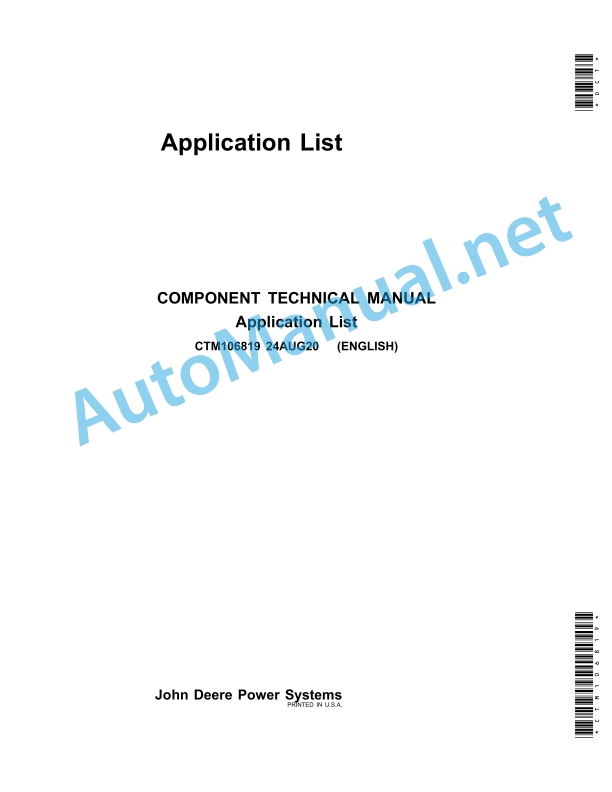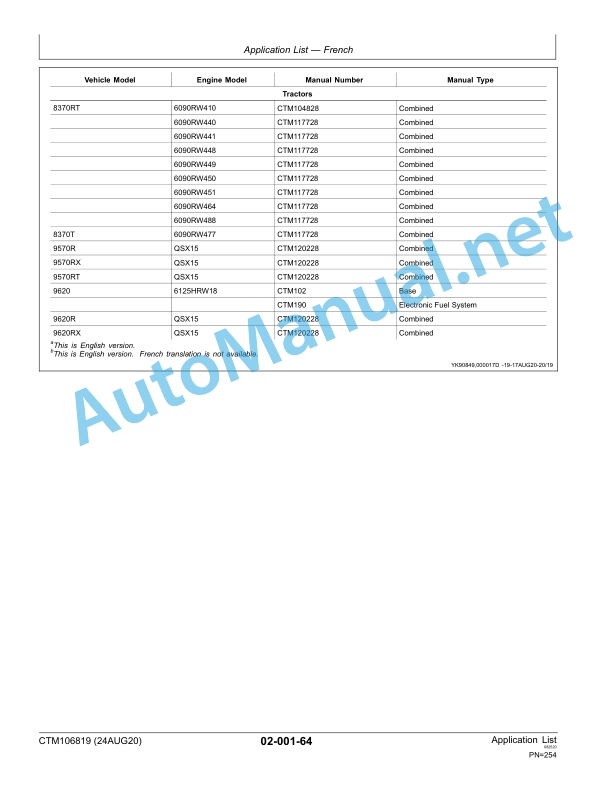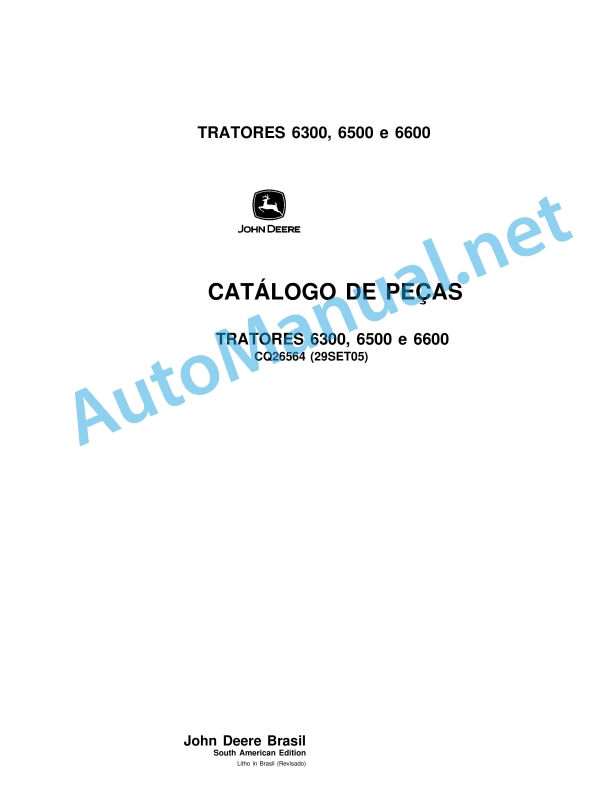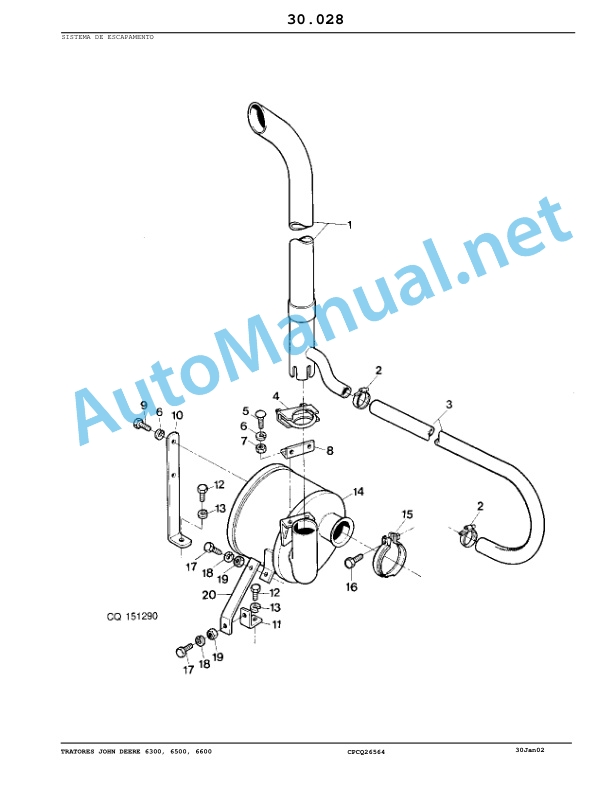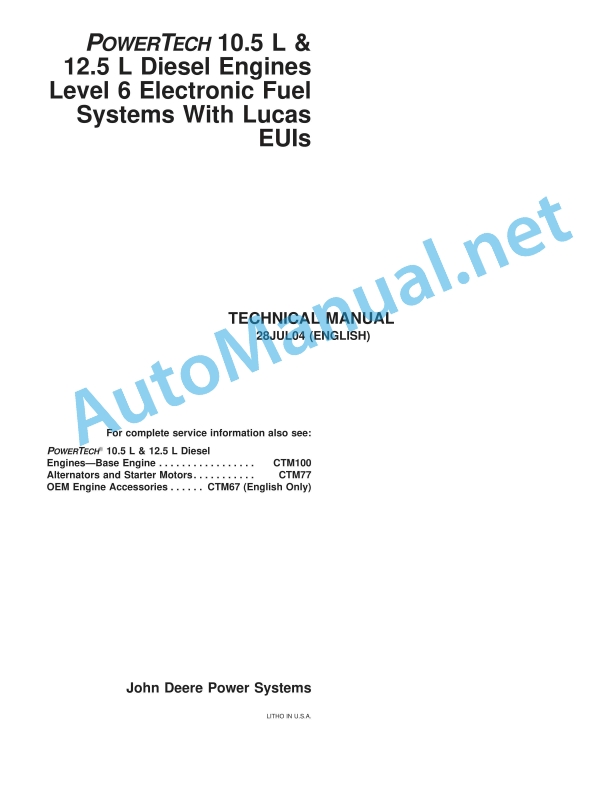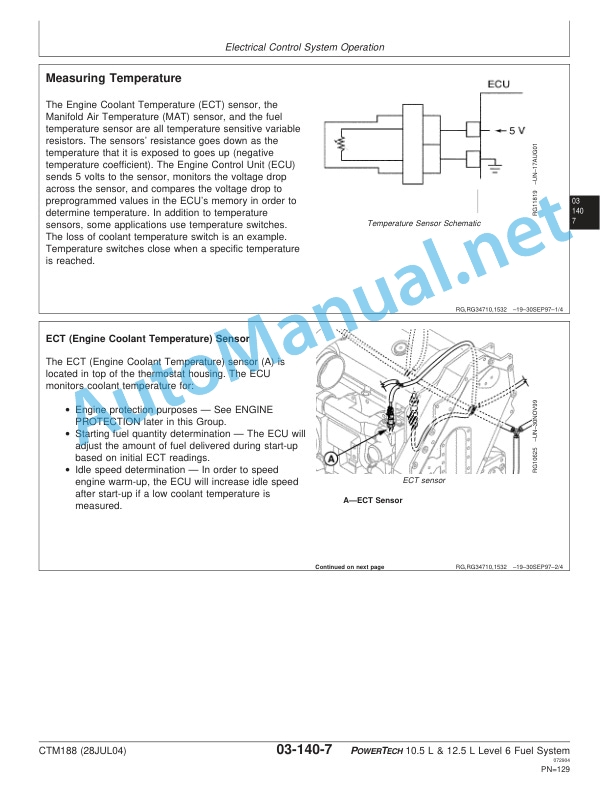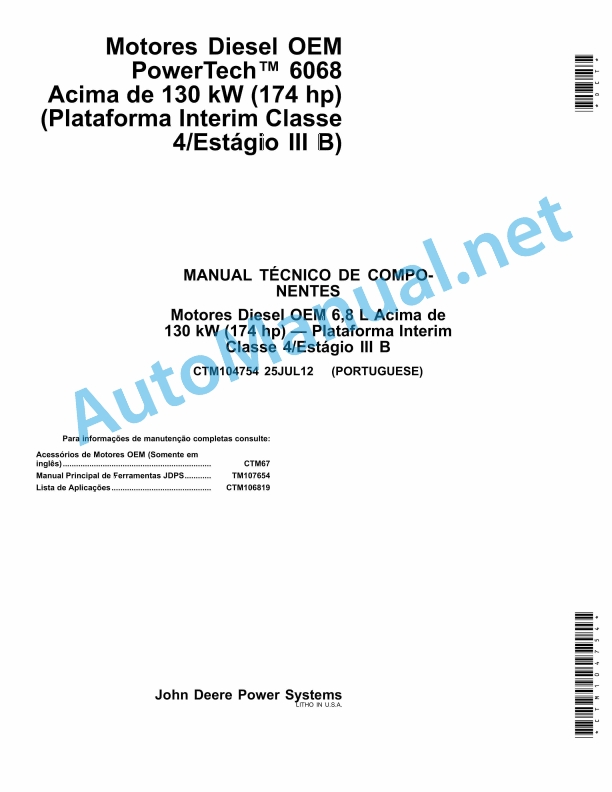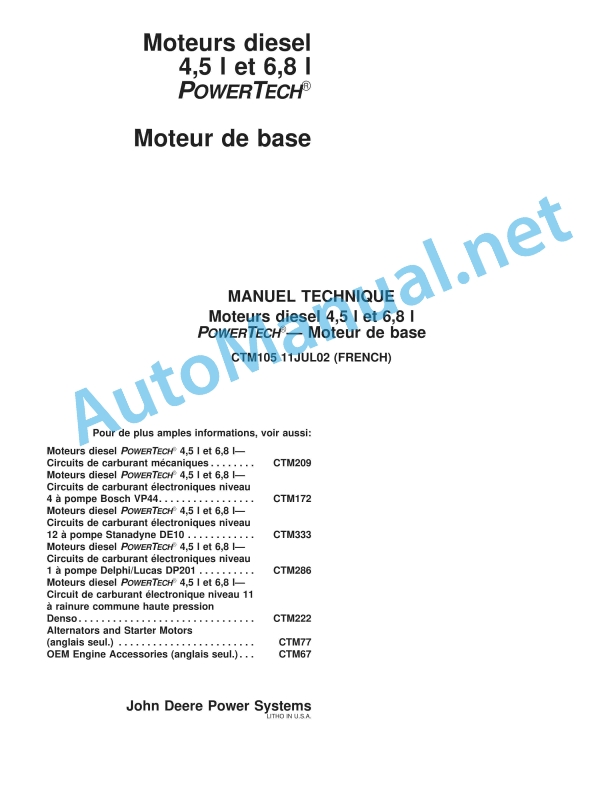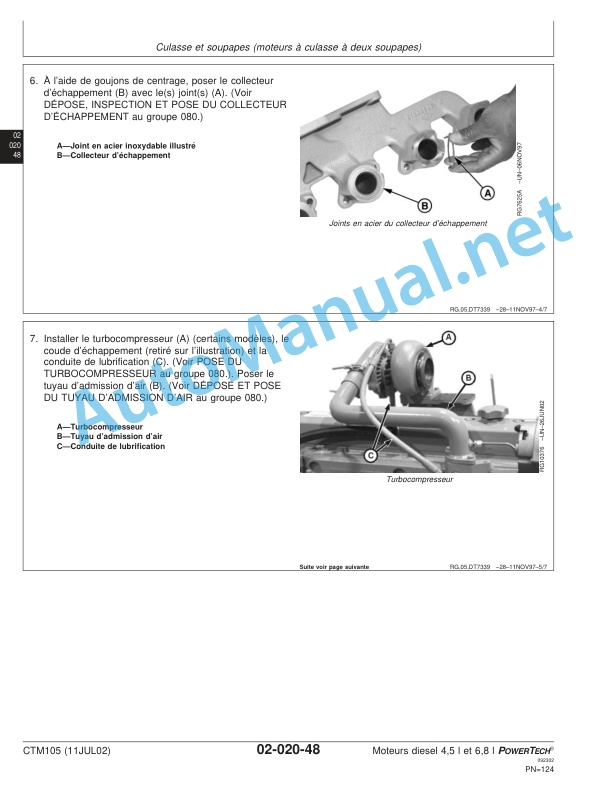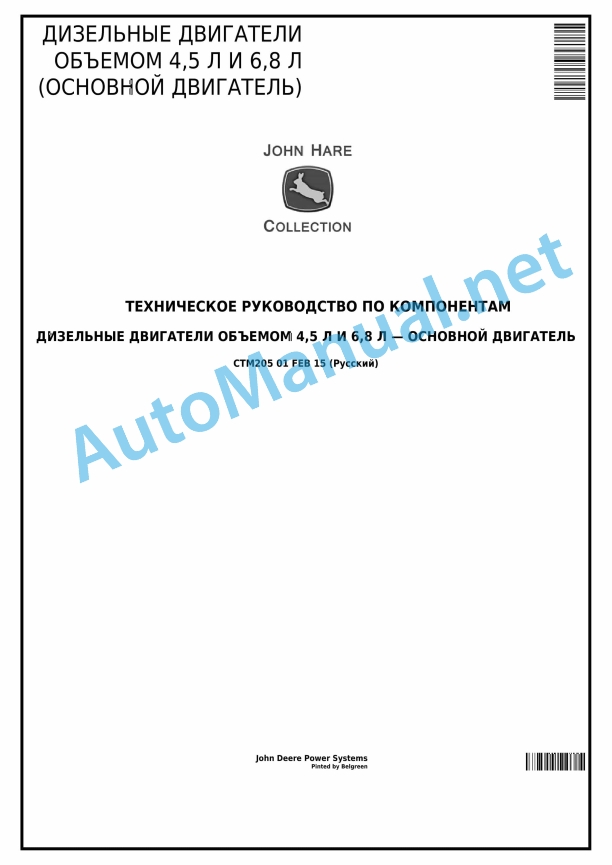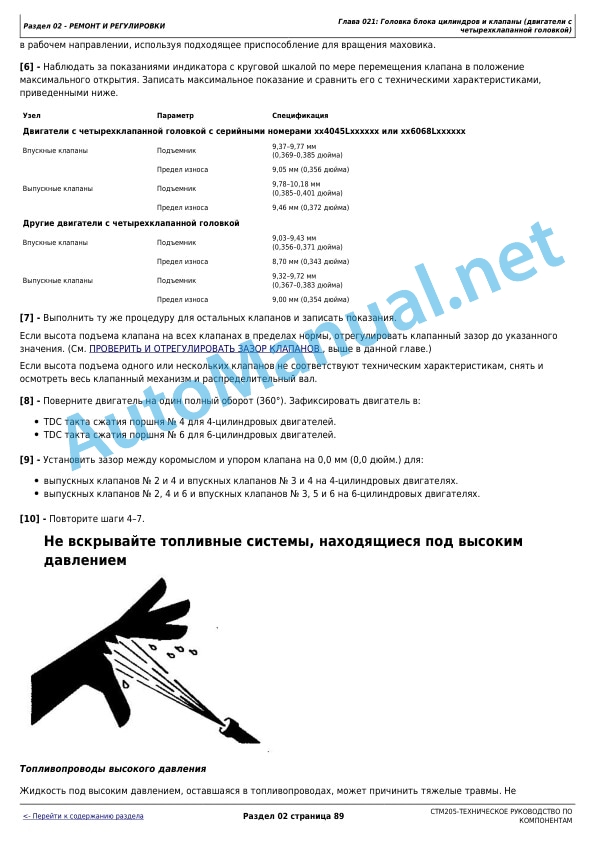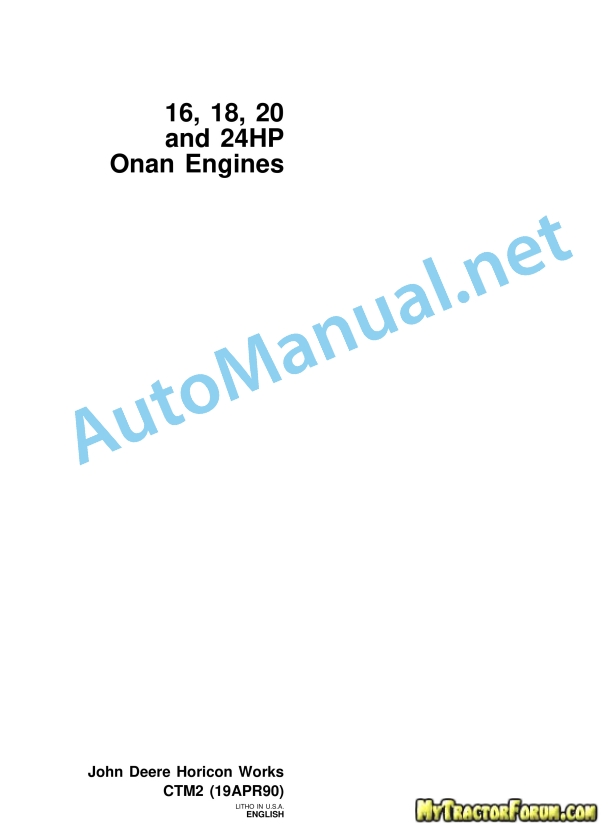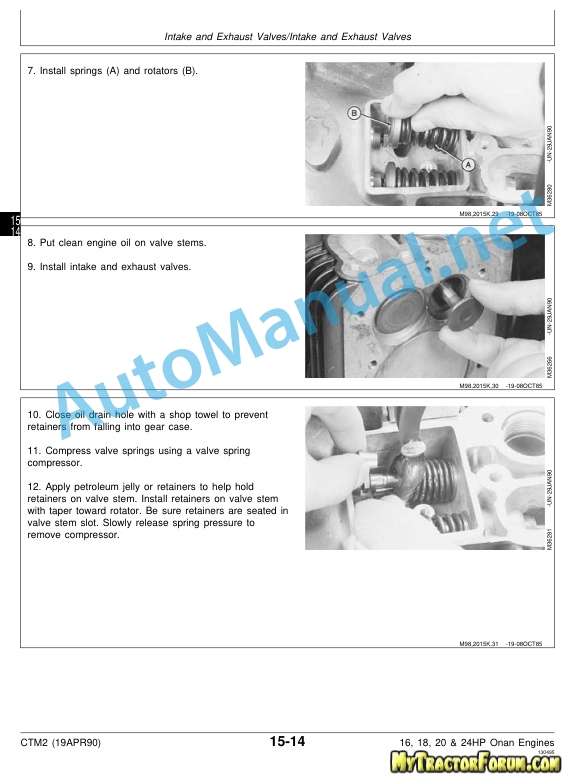Claas Axion 850-820 Nrc (B02) Tractors Operator Manual ES
$50.00
- Model: Axion 850-820 Nrc (B02) Tractors
- Type Of Manual: Operator Manual
- Language: ES
- Format: PDF(s)
- Size: 131 MB
File List:
00 1165 129 0.pdf
00 1165 129 2.pdf
00 1170 297 2.pdf
00 1171 316 0.pdf
00 2610 244 0.pdf
00 1165 129 0.pdf:
AXION 850-820 CIS
1 Regarding this instruction manual
1.1 Information regarding the instruction manual
1.1.1 Use the user manual
Important information about this user manual
Structuring according to tractor subassemblies
Search and find
Direction signs
Specific terminology
Optional equipment and supplementary equipment
1.1.2 Symbols and instructions
Texts and illustrations
Indication of dangers and warnings
1.1.3 Validity of the user manual
1.1.4 Technical instructions
2 Security
2.1 Safety instructions
2.1.1 Use according to assignment
2.1.2 Use not in accordance with assignment
2.1.3 Safety and accident prevention instructions
2.1.4 Tractor driving
2.1.5 Checking the condition of the tractor
2.1.6 Get into the cabin and get off the tractor.
Climb aboard the tractor
Get off the tractor
2.1.7 Passenger seat
2.1.8 Cabin
Cabin safety structure
Polluted environment
2.1.9 Necessary precautions before start-up
2.1.10 Tool attachment
2.1.11 Adjustment and maintenance work
Particularities of placing the tractor on lifting supports
2.1.12 Using the front/rear power take-off
2.1.13 Fuel
2.1.14 Engine coolant
2.1.15 Air conditioning
2.1.16 Electrical system
2.1.17 Applications with front loaders
2.1.18 Forestry applications
2.1.19 Work in fixed position
2.1.20 Implements that work at great depth
2.2 Safety marking on the tractor
2.2.1 General advice regarding safety markings
2.2.2 Warning symbols
2.3 Safety devices
2.3.1 First aid kit holder
2.3.2 Wheel chocks
2.3.3 Signal triangle
2.3.4 Fire extinguisher support
3 Description of the tractor
3.1 Overview
3.1.1 Left front view
3.1.2 Left rear view
3.2 Identification plates and vehicle identification number
3.2.1 Tractor nameplate (type A30)
Tractor identification number
Regulatory tractor type
Tractor serial number
3.2.2 Tractor nameplate (type B02)
3.2.3 Motor plates
Engine nameplate
Emissions certification label
3.2.4 Front axle nameplate
3.2.5 Front power take-off nameplate
3.2.6 Supplementary cabin nameplate
3.3 Information on the tractor
3.3.1 Tractor power label
3.3.2 Electrical and electronic system
3.3.3 Lifting points
3.3.4 Load the tractor
Location of lifting points
00 0514 038 2
Tractor Lifting Procedure Reminder
00 2190 728 0
3.3.5 Wheel tightening
3.3.6 Cabin Filtration Category
4 Control and display instruments
4.1 Cabin and driving position
4.1.1 Dashboard
4.1.2 Multifunction armrest
4.1.3 Right terminal
4.1.4 Cabin height
4.1.5 C.I.S Terminal
4.1.6 Instrument panel
4.1.7 Instrument panel main screen
4.1.8 Right front pillar
4.1.9 Transmission screen
4.1.10 Manual air conditioning control
4.1.11 Control panel for work lights and rotating flashing light
4.1.12 Driving position control levers
Signal lights and acoustic warning
Windshield wipers and washers
4.2 Electrical and electronic system
4.2.1 External controls
Rear external controls
Front external controls
4.3 Hydraulic installation
4.3.1 Hydraulic controls
4.4.1 Introduction to the CIS terminal
4.4.2 CIS menu structure
4.4.3 On-board computer
4.4.4 Transmission
4.4.5 Consumption
4.4.6 Maintenance
4.4.7 Configuration
5 Technical data
5.1 AXION 850-820
5.1.1 Dimensions
5.1.2 Weight
5.1.3 Engine
CLAAS Power Management
5.1.4 Gearbox
5.1.5 Feed speeds
5.1.6 Front axle
Standard front axle
Reinforced front axle
5.1.7 Rear axle
5.1.8 Front track table
Fixed disc rim
flanged rim
5.1.9 Rear track table
Fixed disc rim. flange shafts
Fixed disc rim – 2.5 and 3 m smooth axles
5.1.10 Tire combinations
Rigid front axle and suspended front axle
Reinforced rigid front bridge
5.1.11 Brakes
5.1.12 Address
5.1.13 Rear lift
5.1.14 Front linkage
5.1.15 Rear hitches
5.1.16 Rear PTO
5.1.17 Front power take-off
5.1.18 Main hydraulic circuit (LS 110 l/min)
5.1.19 Main hydraulic circuit (LS 150 l/min)
5.1.20 Electrical circuit
5.1.21 Cabin characteristics
Noise level in the driver’s ears (according to European directive 2009/76)
Noise level in the ears of a passerby (according to European directive 2009/63 Annex VI)
5.1.22 Seat vibration level
5.1.23 Ballast
5.1.24 Maximum allowable towable masses
5.1.25 Load capacities
5.1.26 Lubricants/Hydraulic Oils
5.1.27 Engine coolant
5.1.28 Air conditioning cooling agent
5.1.29 Brake fluid (depending on equipment)
6 Prepare the tractor
6.1 Engine
6.1.1 Fuel
Quality requirement
Particularities of biofuels
Fuel handling
6.1.2 Filling the tractor tank
Filling the fuel tank
6.1.3 Cold Engine Start/Engine Coolant Heater
6.2 Framework
6.2.1 Rear axle track adjustment
flange shafts
Smooth shafts (diameter 110 mm)
Smooth shafts (diameter 95 mm)
6.2.2 Front axle track adjustment
6.2.3 Adjustment of the rotation stops
Jack Placement
Placement of supports
Adjusting the turning stops
6.2.4 General characteristics of the tires
6.2.5 Inflation pressure
Effect on soil compaction
Effect on consumption
Twin Wheel Assembly Case
6.2.6 Features
Load index
speed index
6.2.7 Severe applications
6.2.8 Use wheel chocks
6.3 Brake
6.3.1 Brake pedal engagement
6.3.2 Hydraulic trailer brake
6.3.3 Trailer pneumatic brake
6.4 Address
6.4.1 Steering column
6.5 Rear linkage
6.5.1 Hitching/unhitching an implement
Hitch Recommendations
Disengagement
6.5.2 Lifting supports
6.5.3 Mechanical upper connecting rod
6.5.4 Stabilizers
Mechanical stabilizers
Self-Locking Stabilizers
6.5.5 Automatic hooks
6.5.6 External controls
6.6 Front linkage
6.6.1 Hitching/unhitching an implement
Hitch Recommendations
Disengagement
6.6.2 Mechanical upper connecting rod
6.6.3 Lower cranks
6.6.4 Automatic hooks
6.7 Front loader
6.7.1 Mounting the front loader adapter
6.8 Rear PTO
6.8.1 Attaching/disengaging a tool
Connecting/disconnecting the rear PTO cardan
Disengagement
6.8.2 Rear PTO end
6.9 Front power take-off
6.9.1 Hitching/unhitching an implement
Connecting/disconnecting the front power take-off cardan
Disengagement
6.10 Towing device
6.10.1 Recommendations
6.10.2 Calculation of the maximum towable load
6.10.3 Hitching/unhitching an implement
Disengagement
6.10.4 Hitch pin
6.10.5 Oscillating bar
Lateral positions
Longitudinal displacement
Maximum Hitch Sweep Angles
Safety device
Tightening of the jaw
6.10.6 Hitch forks
Fork with bolt
automatic fork
ball fork
CUNA forks
6.10.7 Eyebolt fork
6.11 Rear hydraulic system
6.11.1 Rear pressure taps
Connection of pressure taps
Disconnection of pressure taps
6.11.2 Connecting an implement to the Power Beyond
6.12 Front hydraulic system
6.12.1 Front pressure points
6.13 Electrical and electronic system
6.13.1 External electrical outlets
Rear external electrical sockets
Front external electrical sockets
6.14 Cabin and driving position
6.14.1 Armrest
6.14.2 Mirror adjustment
Mirror clearance adjustment
Adjusting the orientation of the mirrors (manual adjustment)
6.14.3 Mechanical Suspension Seat Adjustment
6.14.4 Seat adjustment with air suspension
6.14.5 Passenger seat
6.14.6 Installation of a control console in the cabin
6.14.7 Passage of the cables of a control console
6.14.8 Refrigerated compartment
6.14.9 Compartments
roof compartment
Compartments on the left
6.14.10 Cab suspension adjustment
6.15 Assembly and body parts
6.15.1 Opening and closing the hood
6.15.2 Side covers
Disassembly
Mounting
6.15.3 Ballast
6.15.4 Liquid ballast
6.15.5 Balancing the tractor with mounted implements
Summary table
6.15.6 Weight on the front hydraulic lift
6.15.7 Assembly and disassembly of the front masses
Removable masses
Base front monobloc mass
Additional front monobloc mass
6.15.8 Rear wheel weights
Wheel weights for 42” rims
Wheel weights for 38” rims
6.15.9 Toolbox
6.16 Tractor transport
6.16.1 Transport
6.16.2 Tractor loading
7 Management
7.1 Engine
7.1.1 Break-in
7.1.2 Engine starting
7.1.3 Accelerator pedal
7.1.4 Hand throttle
7.1.5 Engine speed memories
Activation of an engipmemory
Manual adjustment of engine speed memories (method 1)
Manual adjustment of engine speed memories (method 2)
7.1.6 Engine stop
7.2 Transmission, clutch and cardan shaft
7.2.1 Protection of mechanical organs
7.2.2 Clutch pedal
7.2.3 Put the transmission in neutral
Put the transmission in neutral
Transmission reactivation
7.2.4 Selection of tractor forward direction
7.2.5 Progressivity of the reversal of the direction of advance
7.2.6 Transport Mode
Activating Transport mode
Gear change and speed ranges
7.2.7 Work mode
Activation of Work mode
Gear change and speed ranges
7.2.8 “Skip Shift”
7.2.9 “Speed Matching”
7.2.10 Engaging/disengaging forward/reverse gears
7.2.11 «Hexactiv» gear change automation
Description of the “Hexactiv” automation
Use of the «Hexactiv» automation
“Hexactiv” automation adjustment
Automatic Mode (3)
Manual Mode (4)
imitaation
7.2.12 Starting run
Starting run in
7.2.13 Maneuvering run
7.2.14 Locking the differentials
Automatic mode
Permanent mode
7.3 Chassis
7.3.1 Front axle activation
Automatic mode
Permanent mode
7.3.2 Front axle suspension
Fixed mode
Automatic mode
7.4 Brake
7.4.1 Service brakes
7.4.2 Handbrake
7.4.3 Automatic parking brake
7.5 Rear linkage
7.5.1 Recommendations
7.5.2 Transport security
7.5.3 Unlocking the rear linkage
7.5.4 Rear lifting mechanism raising/lowering controls
7.5.5 Position control
7.5.6 Effort control
7.5.7 Upper stop
7.5.8 Descent speed
7.5.9 Transport buffer
7.5.10 Active skating management
7.6 Front linkage (front linkage controlled by distributor 1)
7.6.1 Recommendations
7.6.2 Transport security
7.6.3 Use of the front linkage
Unlocking the front linkage
Front linkage raisiowering
7.6.4 Transport buffer
7.7 Rear PTO
7.7.1 Recommendations
7.7.2 PTO speed selection
Regimes 540/1000 and 540/1000/540ECO
Regimes 1000ECO/1000/540ECO
7.7.3 Use of external controls
7.7.4 Use of the control in the cabin
7.7.5 Rear power take-off automation
Adjustment
7.7.6 Work in fixed position
7.8 Front power take-off
7.8.1 Recommendations
7.8.2 Use of the control in the cabin
7.8.3 Work in fixed position
7.9 Rear hydraulic system
7.9.1 Association of the controls with the rear pressure taps
Distribution block composed of three rear hydraulic distributors
Distribution block composed of 4 rear hydraulic distributors
7.9.2 Hydraulic distributor adjustment wheels
7.9.3 Use of levers
7.9.4 Adjustment of the flow rate of the pressure taps of the hydraulic distributors
7.9.5 “Power Beyond”
7.9.6 Work in fixed position
7.10 Front hydraulic system (front pressure intakes controlled with distributor 3)
0.1 Association of controls with t pressure intakes
7.10.2 Use of the lever
7.10.3 Adjustment of the flow rate of the front pressure intakes
7.10.4 Work in fixed position
7.11 Electrical and electronic system
7.11.1 Manual circuit breaker
7.12 Cabin and driving position
7.12.1 Instrument panel displays
Main screen
7.12.2 Manual air conditioning control
Regulation of ventilated air flow
Ventilated air temperature adjustment
Ventilation orientation management
Activation of air cooling
Activation of air recirculation
7.12.3 Monitoring the filling level of the cabin’s external air prefilter
7.12.4 Ceiling light
8 Incident and solution
8.1 Alarms
8.1.1 Primary alarms
8.1.2 Engine coolant temperature too high
8.1.3 Incorrect engine oil pressure
8.1.4 Brake fluid level
8.1.5 Tractor braking system pressure failure
8.1.6 Incorrect hydraulic circuit oil pressure
8.1.7 Hydraulic oil temperature too high
8.1.8 Insufficient pressure in the trailer brake circuit
8.1.9 Presence of water in the fuel prefilter
8.1.10 Battery charging
8.1.11 Parking brake applied
8.1.12 Secondary alarms
8.1.13 Engine air filter clogging
8.1.14 Clogged hydraulic oil filter
8.1.15 Other alarms
Fuel level warning light
Preheating indicator
8.1.16 Reminder of maintenance to be carried out every 500 hours of service
Maintenance counter reset
8.1.17 Reminder of maintenance to be carried out every 1,000 hours of service
Maintenance counter reset
8.1.18 Reminder for maintenance operations to be carried out at the frequency defined by the user
Maintenance counter reset
8.1.19 Indication of an active error code
Consultation of active error codes
8.1.20 Steps to resolve various anomalies
8.2 Engine
8.2.1 Failure due to lack of fuel
8.2.2 Startup assistance
Tow-assisted start
Starting assisted by external battery
8.2.3 Decrease in engine performance
8.3 Transmission, clutch and cardan shaft
8.3.1 Inadequate HEXASHIFT gearbox oil temperature
Operation of the HEXASHIFT box in cold temperatures
8.4 Framework
8.4.1 Jack placement
8.4.2 Changing a wheel
8.4.3 Tractor trailer
Trailer with engine running
Trailer with engine off
8.4.4 Unclogging the tractor
Tractor unclogging
Unclogging a tractor by towing
8.5 Electrical and electronic system
8.5.1 Fuses and relays
Relay and fuse board
Cabin top plate
Primary fuse board
8.5.2 Lights overview
8.5.3 Instrument panel calibration
8.6 Cabin and driving position
8.6.1 Failure of air cooling in the cabin
8.7 Assembly and body parts
8.7.1 Frontal impact on the monobloc weight located at the front of the tractor
9 Maintenance
9.1 Maintenance instructions
9.1.1 Personal protective equipment
9.1.2 Stopping and securing the tractor
9.1.3 Clean and organize risk areas
9.1.4 Welding instructions
9.1.5 Protection devices on the tractor
9.1.6 Engine
Alternator
Engine lubrication
engine cooling
engine belts
9.1.7 Wheels and tires
9.1.8 Braking system
9.1.9 Pneumatic circuit
9.1.10 Address
9.1.11 PTO driven implements
9.1.12 Air conditioning
9.1.13 Hydraulic circuit
9.1.14 Electrical system
9.1.15 Energy accumulators
9.1.16 Spare parts
9.1.17 Cleaning/protection
9.1.18 Work at height
9.1.19 Handling of heavy parts
9.1.20 Maintenance operations in the cabin
9.1.21 Lifting the front of the tractor
9.2 Summary of maintenance intervals
9.2.1 Management of maintenance intervals
9.2.2 First 10 hours
9.2.3 First 40 hours
9.2.4 First 100 hours
9.2.5 First 500 hours
9.2.6 Every day
9.2.7 Weekly
9.2.8 Every 50 hours
9.2.9 Monthly
9.2.10 Every 100 hours
9.2.11 Every 100 hours or monthly
9.2.12 Every 200 hours
9.2.13 Every 300 hours
9.2.14 Every 400 hours
9.2.15 Every 500 hours
9.2.16 Every 500 hours or every 6 months
9.2.17 Every 500 hours or annually
9.2.18 Every 800 hours
9.2.19 Every 1000 hours
9.2.20 Every 1500 hours or every two years
9.2.21 Every 2000 hours
9.2.22 Every 2,000 hours or every two years
9.2.23 Every 3000 hours or every three years
9.2.24 Every 4500 hours or every 5 years
9.3 Greasing scheme
9.3.1 Grease points, 50 h
9.3.2 Grease points (500 hours or 3 months)
9.3.3 Grease points – 500 hours or 6 months
9.3.4 Grease points, 500 h (AXION 820-810)
9.4 Engine maintenance operations
9.4.1 Replacing the 6-cylinder engine vibration damper (front face)
9.4.2 Adjustment of the rocker arms
9.4.3 Elimination of water present in fuel
Fuel decanter prefilter
Fuel filter
9.4.4 Changing fuel filters
Fuel decanter prefilter
fuel prefilter
Fuel filter
9.4.5 Checking the fuel strainer
9.4.6 Changing the fuel strainer
9.4.7 Checking the injection system fittings
9.4.8 Bleeding air from the fuel circuit
9.4.9 Cleaning the engine injection circuit
9.4.10 Engine oil level check
9.4.11 Engine oil change
9.4.12 Changing the engine oil filter
9.4.13 Coolant level control
9.4.14 Changing the engine cooling circuit fluid
9.4.15 Check the tightness of the cooling circuit
9.4.16 Cleaning of refrigerators
9.4.17 Fan control
9.4.18 Check the tightness of the air intake.
9.4.19 Clean the engine air filter
9.4.20 Change the engine air filter
9.4.21 Replacing the air filter and engine safety cartridge
9.4.22 Engine Error Code History
9.5 Gear maintenance operations
9.5.1 Radial play check of the front axle transmission cardan crossheads
9.5.2 Checking the oil level of the rear axle final reductions
9.5.3 Changing the rear axle final reduction oil
9.5.4 Replacing the rear axle vents
9.6 Chassis maintenance work
9.6.1 Check the front axle differential case oil level
9.6.2 Change the front axle differential case oil
9.6.3 Check the oil level of the front axle final reductions
9.6.4 Change the oil in the front axle final reductions
9.6.5 Check tire inflation pressure
9.6.6 Checking the tightening of the wheel discs on the hubs
9.6.7 Checking the tightening of the wheel discs on the rims
9.6.8 Checking the tightening of the connecting screws
9.7 Brake maintenance operations
9.7.1 Changing the circuit breaker filter
9.7.2 Checking the brake fluid level
9.7.3 Changing the service brake fluid
9.7.4 Changing the braking circuit reservoir cap
9.7.5 Handbrake clearance adjustment
9.7.6 Checking the coupling heads of the pneumatic braking system
9.7.7 Checking the trailer pneumatic braking system bleed valves
9.8 Hitch device maintenance operations
9.8.1 Checking the fork play
Hitch Pin Diameter
automatic fork
Locking rods
9.9 Front power take-off maintenance operations
9.9.1 Checking the oil level of the front power take-off box
«MX» power takeff box
«ZUIDBERG» power take-off box
9.9.2 Changing the oil in the front power take-off box
«MX» power take-off box
«Zuidberg» power take-off box
9.10 Hydraulic installation maintenance work
9.10.1 Check the hydraulic circuit.
9.10.2 Checking the hydraulic/transmission oil level
9.10.3 Hydraulic/transmission oil change
9.10.4 Changing the hydraulic circuit oil filters
High pressure hydraulic oil filter (1)
Low pressure hydraulic oil filter (2)
9.10.5 Changing the auxiliary hydraulic circuit shower head
9.10.6 Emptying the oil recovery drums
9.11 Electrical/electronic installation maintenance work
9.11.1 Cleaning and greasing the battery terminals
9.12 Cabin/driving position maintenance operations
9.12.1 Cleaning the cabin shock absorbers
9.12.2 Checking the window washer fluid level
9.12.3 Cleaning the cabin exterior air prefilter
9.12.4 Cleaning the cabin air pre-filter
9.12.5 the pre-filter and cabin air filter
.6 Changing the cabin air recirculation filter
9.12.7 Start the air conditioning
9.13 Bodywork maintenance operations
9.13.1 Cleaning the calender grates
9.13.2 Checking the tightness of the engine cover
9.13.3 Checking the tightening of the front weight fixing screws
9.13.4 Check the tightening of the additional rear wheel masses
9.14 Parking
9.14.1 Parking instructions
Long term parking
New commissioning
10 Service
10.1 AXION 850-820
10.1.1 Spare parts and technical issues
11 Decommissioning and waste disposal
11.1 Information about the machine
11.1.1 Disposal and waste disposal
12 Technical dictionary and abbreviations
12.1 Technical dictionary and abbreviations
12.1.1 Technical terms
12.1.2 Abbreviations
00 1165 129 2.pdf:
User manual
1. Introduction
1.1 Information regarding the instruction manual
1.1.1 Use the user manual
Important information about this user manual
Structuring according to tractor subassemblies
Search and find
Direction signs
Specific terminology
Optional equipment and supplementary equipment
1.1.2 Symbols and instructions
Texts and illustrations
Indication of dangers and warnings
1.1.3 Validity of the user manual
1.1.4 Software updates
1.1.5 Technical instructions
1.1.6 Spare parts and technical issues
2 Security
2.1 Safety instructions
2.1.1 Use according to assignment
2.1.2 Use not in accordance with assignment
2.1.3 Safety and accident prevention instructions
2.1.4 Tractor driving
2.1.5 Checking the condition of the tractor
2.1.6 Get into the cabin and get off the tractor.
Climb aboard the tractor
Get off the tractor
2.1.7 Passenger seat
2.1.8 Cabin
Cabin safety structure
Polluted environment
2.1.9 Necessary precautions before start-up
2.1.10 Tool attachment
2.1.11 Adjustment and maintenance work
Particularities of placing the tractor on lifting supports
2.1.12 Use of the front and rear power take-offs
2.1.13 Fuel
2.1.14 Engine coolant
2.1.15 Air conditioning
2.1.16 Electrical system
2.1.17 Applications with front loaders
2.1.18 Forestry applications
2.1.19 Work in fixed position
2.1.20 Implements that work at great depth
2.1.21 Transfer of the tractor to a third party
2.2 Safety marking on the tractor
2.2.1 General advice regarding safety markings
2.2.2 Warning symbols
2.3 Safety devices
2.3.1 First aid kit holder
2.3.2 Wheel chocks
2.3.3 Signal triangle
2.3.4 Fire extinguisher support
3 Description of the tractor
3.1 Overview
3.1.1 Left front view
3.1.2 Left rear view
3.2 Identification plates and vehicle identification number
3.2.1 Tractor nameplate
Tractor nameplate (European version 1)
Tractor nameplate (European version 2)
Tractor nameplate (international version)
Tractor nameplate (Eurasian version 1)
Tractor nameplate (Eurasian version 2)
Tractor identification number
Regulatory tractor type
Tractor serial number
3.2.2 Tractor power label
3.2.3 Motor plates
Engine nameplate
Emissions certification label
3.2.4 Front axle nameplate
3.2.5 Front power take-off nameplate
3.2.6 Supplementary cabin nameplate
Supplementary nameplate (European version 1)
Supplementary nameplate (European version 2)
International supplementary nameplate
Eurasian supplementary nameplate
3.3 Information on the tractor
3.3.1 Electrical and electronic system
3.3.2 Lifting points
3.3.3 Load the tractor
Location of lifting points
00 0514 038 2
Tractor Lifting Procedure Reminder
00 2673 921 0
3.3.4 Wheel tightening
3.3.5 Brake fluid
3.3.6 Cabin Filtration Category
4 Control and display instruments
4.1 Cabin and driving position
4.1.1 Dashboard
4.1.2 Multifunction armrest
4.1.3 Right terminal
4.1.4 Cabin height
4.1.5 C.I.S Terminal
4.1.6 Instrument panel
4.1.7 Instrument panel main screen
4.1.8 Right front pillar
4.1.9 Transmission screen
4.1.10 Manual air conditioning control
4.1.11 Control panel for work lights and rotating flashing light
4.1.12 Driving position control levers
Signal lights and acoustic warning
Windshield wipers and washers
4.2 Electrical and electronic system
4.2.1 External controls
Rear external controls
Front external controls
4.3 Hydraulic installation
4.3.1 Hydraulic controls
4.4.1 Introduction to the CIS terminal
4.4.2 CIS menu structure
4.4.3 On-board computer
4.4.4 Transmission
4.4.5 Consumption
4.4.6 Maintenance
4.4.7 Configuration
5 Technical data
5.1 AXION 850-820
5.1.1 Dimensions
5.1.2 Weight
5.1.3 Engine
CLAAS POWER MANAGEMENT
5.1.4 Gearbox
5.1.5 Feed speeds
5.1.6 Front axle
Standard front axle
Reinforced front axle
5.1.7 Rear axle
5.1.8 Front track table
Fixed disc rim
Variable disc rim
5.1.9 Rear track table
Variable disc rim. flange shafts
Fixed disc rim. flange shafts
Fixed disc rim – 2.5 and 3 m smooth axles
5.1.10 Rear track table with twin wheel spacers
Fixed disc rim, track with 2.5 meter smooth axles
Fixed disc rim, track with 3 meter smooth axles
5.1.11 Tire combinations
Variable disc rims on rigid or suspended front axle
Fixed disc wheels on rigid or suspended front axle
Reinforced rigid front bridge
5.1.12 Brakes
5.1.13 Address
5.1.14 Rear linkage
5.1.15 Front linkage
5.1.16 Rear hitches
5.1.17 Rear PTO
5.1.18 Front power take-off
5.1.19 Main hydraulic circuit (LS 110 l/min)
5.1.20 Main hydraulic circuit (LS 150 l/min)
5.1.21 Electrical circuit
5.1.22 Cabin characteristics
Noise level in the driver’s ears (according to European directive 2009/76)
Noise level in the ears of a passerby (according to European directive 2009/63 Annex VI)
5.1.23 Seat vibration level
5.1.24 Ballast
5.1.25 Maximum allowable towable masses
5.1.26 Load capacities
5.2 Inputs
5.2.1 Lubricants and hydraulic oils
5.2.2 Engine coolant
5.2.3 Air conditioning cooling agent
5.2.4 Brake fluid (depending on equipment)
6 Prepare the tractor
6.1 Engine
6.1.1 Fuel
Quality requirement
Particularities of biofuels
Fuel handling
6.1.2 Filling the tractor tank
Filling the fuel tank
6.1.3 Cold Engine Start/Engine Coolant Heater
6.2 Framework
6.2.1 Rear axle track adjustment
Flanged wheel axles
smooth shafts
smooth shafts
6.2.2 Front axle track adjustment
6.2.3 Adjustment of the rotation stops
Jack Placement
Placement of supports
Adjusting the turning stops
6.2.4 General characteristics of the tires
6.2.5 Tire inflation pressure
Effect on soil compaction
Effect on consumption
Twin Wheel Assembly Case
6.2.6 Features
Load index
speed index
6.2.7 Severe applications
6.2.8 Placement of spacers for mounting twin wheels
AXION 820
AXION 850
6.2.9 Use wheel chocks
6.3 Brake
6.3.1 Brake pedal engagement
6.3.2 Hydraulic trailer brake
6.3.3 Trailer pneumatic brake
Service pneumatic pressure connection
6.4 Address
6.4.1 Steering column
6.4.2 Connect third-party guidance system to steering interface
6.5 Rear linkage
6.5.1 Hitching/unhitching an implement
Hitch Recommendations
Disengagement
6.5.2 Lifting supports
6.5.3 Mechanical upper connecting rod
6.5.4 Stabilizers
Mechanical stabilizers
Self-Locking Stabilizers
6.5.5 Automatic hooks
6.5.6 External controls
6.6 Front linkage
6.6.1 Hitching/unhitching an implement
Hitch Recommendations
Disengagement
6.6.2 Mechanical upper connecting rod
6.6.3 Lower cranks
6.6.4 Automatic hooks
6.7 Front loader
6.7.1 Mounting the front loader adapter
6.8 Rear PTO
6.8.1 Hitching and unhitching an implement
Connecting and disconnecting the rear power take-off cardan
Disengagement
6.8.2 Replacing the rear power take-off terminal
6.9 Front power take-off
6.9.1 Hitching and unhitching an implement
Disengagement
6.10 Towing device
6.10.1 Recommendations
6.10.2 Calculation of the maximum towable load
6.10.3 Hitching/unhitching an implement
Disengagement
6.10.4 Hitch pin
6.10.5 Oscillating bar
Lateral positions
Longitudinal displacement
Maximum Hitch Sweep Angles
Safety device
Tightening of the jaw
6.10.6 Hitch forks
Fork with bolt
automatic fork
ball fork
CUNA forks
6.10.7 Eyebolt fork
6.11 Rear hydraulic system
6.11.1 Rear pressure taps
Connection of pressure taps
Disconnection of pressure taps
6.11.2 Connecting an implement to the Power Beyond
6.12 Front hydraulic system
6.12.1 Front pressure points
6.13 Electrical and electronic system
6.13.1 External electrical outlets
Rear external electrical sockets
Front external electrical sockets
6.13.2 Adjust the low beam headlights
Engine hood dipped headlights
6.14 Cabin and driving position
6.14.1 Armrest
6.14.2 Mirror adjustment
Mirror clearance adjustment
Adjusting the orientation of the mirrors (manual adjustment)
6.14.3 Mechanical Suspension Seat Adjustment
6.14.4 Seat adjustment with air suspension
6.14.5 Passenger seat
6.14.6 Installation of a control console in the cabin
6.14.7 Passage of the cables of a control console
6.14.8 Refrigerated compartment
6.14.9 Compartments
roof compartment
Compartments on the left
6.14.10 Cab suspension adjustment
6.15 Assembly and body parts
6.15.1 Opening and closing the hood
6.15.2 Side covers
Disassembly
Mounting
6.15.3 Ballast
6.15.4 Liquid ballast
6.15.5 Balancing the tractor with mounted implements
Summary table
6.15.6 Mass on the front hydraulic linkage
6.15.7 Assembly and disassembly of the front masses
Removable masses
Base front monobloc mass
Additional front monobloc mass
6.15.8 Rear wheel weights
Wheel weights for 42” rims
Wheel weights for 38” rims
6.15.9 Toolbox
6.16 Tractor transport
6.16.1 Tractor transport
6.16.2 Tractor loading
7 Management
7.1 Engine
7.1.1 Break-in
7.1.2 Engine starting
7.1.3 Accelerator pedal
7.1.4 Hand throttle
7.1.5 Engine speed memories
Activation of an engine speed memory
Manual adjustment of engine speed memories (method 1)
Manual adjustment of engine speed memories (method 2)
7.1.6 Engine stop
7.2 Transmission, clutch and cardan shaft
7.2.1 ection of mechanical organs
7.2.2 Clutch pedal
7.2.3 Put the transmission in neutral
Put the transmission in ral
Transmission reactivation
7.2.4 Selection of the direction of travel of the tractor
7.2.5 Progressivity of the reversal of the direction of advance
7.2.6 Transport Mode
Activating Transport mode
Gear change and speed ranges
7.2.7 Work Mode
Activation of Work mode
Gear change and speed ranges
7.2.8 “Skip Shift” function
7.2.9 “Speed Matching”
7.2.10 Engaging/disengaging forward/reverse gears
7.2.11 «Hexactiv» gear change automation
Description of the “Hexactiv” automation
Use of the «Hexactiv» automation
“Hexactiv” automation adjustment
Automatic Mode (3)
Manual Mode (4)
PTO mode (5)
Limitation of “Hexactiv” automation
7.2.12 Starting run
John Deere Repair Technical Manual PDF
John Deere 18-Speed PST Repair Manual Component Technical Manual CTM168 10DEC07
John Deere Repair Technical Manual PDF
John Deere Diesel Engines PowerTech 4.5L and 6.8L – Motor Base Technical Manual 07MAY08 Portuguese
John Deere Repair Technical Manual PDF
John Deere Repair Technical Manual PDF
John Deere Application List Component Technical Manual CTM106819 24AUG20
John Deere Parts Catalog PDF
John Deere Tractors 6300, 6500, and 6600 Parts Catalog CQ26564 (29SET05) Portuguese
John Deere Repair Technical Manual PDF
John Deere Repair Technical Manual PDF
John Deere Repair Technical Manual PDF
John Deere Repair Technical Manual PDF
John Deere Repair Technical Manual PDF
John Deere 16, 18, 20 and 24HP Onan Engines Component Technical Manual CTM2 (19APR90)

